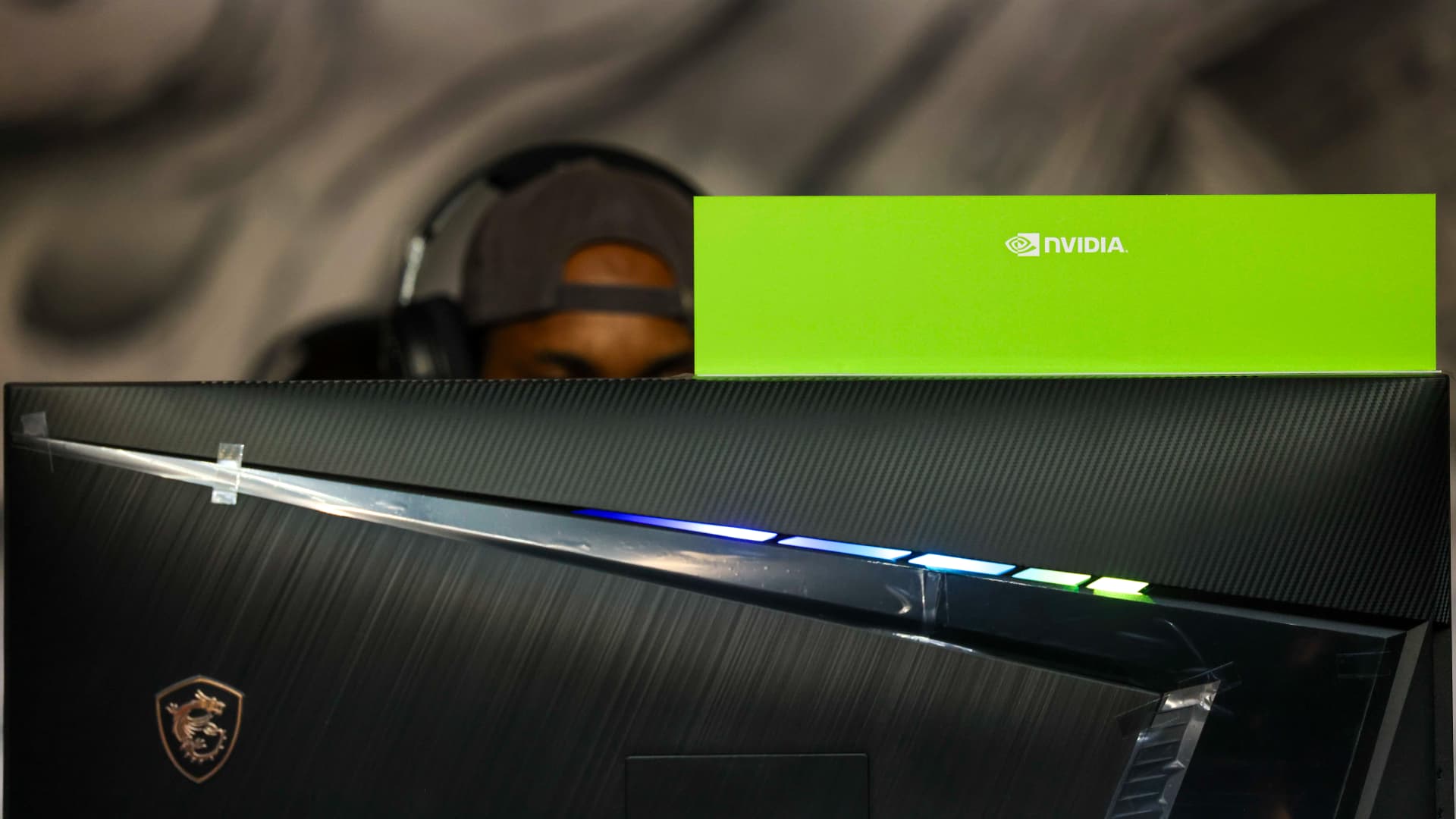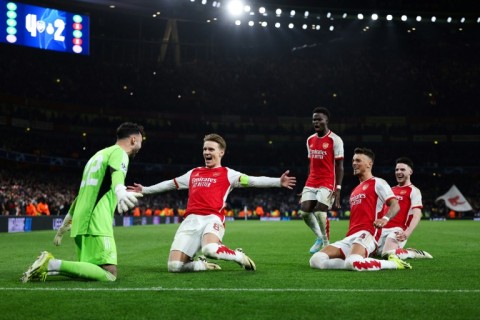Business
The first minds to be controlled by generative AI will live inside video games

A gamer uses a computer powered with an Nvidia Corp. chip at the Gamescon video games trade fair in Cologne, Germany, on Wednesday, Aug. 23, 2023. Gamescon runs until Sunday, Aug. 27. Photographer: Alex Kraus/Bloomberg via Getty Images
Bloomberg | Bloomberg | Getty Images
It’s not just human life that will be remade by the rapid advance in generative artificial intelligence. NPCs (non-playable characters), the figures who populate generated worlds in video games but have to date largely run on limited scripts — think the proprietor of the store you enter — are being tested as one of the first core gaming aspects where AI can improve gameplay and immersiveness. A recent partnership between Microsoft Xbox and Inworld AI is a prime example.
Better dialogue is just the first step. “We’re creating the tech that allows NPCs to evolve beyond predefined roles, adapt to player behavior, learn from interactions, and contribute to a living, breathing game world,” said Kylan Gibbs, chief product officer and co-founder of Inworld AI. “AI NPCs are not just a technological leap. They’re a paradigm shift for player engagement.”
It’s also a big opportunity for the gaming companies and game developers. Shifting from scripted dialogue to dynamic player-driven narratives will increase immersion in a way that drives replayability, retention, and revenue.
The interaction between powerful chips and gaming has for years been part of the success story at Nvidia, but there is now a clear sense in the gaming industry that it is just beginning to get to the point where AI will take off, after some initial uncertainty.
“All developers are interested in how artificial intelligence can impact game development process,” John Spitzer, vice president of developer and performance technology at Nvidia, recently told CNBC, and he cited powering non-playable characters as a key test case.
It’s always been true that technological limits and possibilities overdetermine the gaming worlds developers can create. The technology behind AI NPCs, Gibbs says, will become a catalyst for a new era of storytelling, creative expression, and innovative gameplay. But much of what is to come will be “games we have yet to imagine,” he said.
Bing Gordon, an Inworld advisor and former chief creative officer at Electronic Arts, said the biggest advancements in gaming in recent decades have been through improvements in visual fidelity and graphics. Gordon, who is now chief product officer at venture capital firm Kleiner Perkins and serves on the board of gaming company Take-Two Interactive, believes AI will remake the world of both the gamer and game designer.
“AI will enable truly immersive worlds and sophisticated narratives that put players at the center of the fantasy,” Gordon said. “Moreover, AI that influences fundamental game mechanics has the potential to increase engagement and draw players deeper into your game.”
The first big opportunity for gen AI may be in gaming production. “That’s where we expect to see a major impact first,” said Anders Christofferson, a partner within Bain & Company’s media & entertainment practice.
In other professional tasks, such as creating presentations using software like PowerPoint and first drafts of speeches, gen AI is already doing days of work in minutes. Initial storyboard design and NPC dialogue creation are made for gen AI, and that will free up developer time to focus on the more immersive and creative parts of game making, Christofferson said.
Creating unpredictable worlds
A recent Bain study noted that AI is already taking on some tasks, including preproduction and planning out of game content. Soon it will play a larger role in developing characters, dialogue, and environments. Gaming executives, Bain’s research shows, expect AI to manage more than half of game development within five years to a decade. This may not lead to lower production costs — blockbuster games can run up total development costs of $1 billion — but AI will allow games to be delivered more quickly, and with enhanced quality.
Ultimately, the proliferation of gen AI should allow the development process of games to include the average gamer in content creation. This means that more games will offer what Christofferson calls a “create mode” allowing for increased user-generated content — Gibbs referred to it as “player-driven narratives.”
The current human talent shortage, a labor issue that exists across the software engineering space, isn’t something AI will solve in the short-term. But it may free developers up to put more time into creative tasks and learn how best to use the new technology as they experiment. A recent CNBC study found that across the labor force, 72% of workers who use AI say it makes them more productive, consistent with research Microsoft has conducted on the impact of its Copilot AI in the workplace.
“GenAI is very nascent in gaming and the emerging landscape of players, services, etc. is very dynamic – changing by the day,” Christofferson said. “As with any emerging technologies, we expect lots of learning to take place regarding GenAI over the next few years.”
Given how much change is taking place in gaming, it may simply be too difficult to forecast AI’s scale at the moment, says Julian Togelius, associate professor of computer science and engineering at New York University. He summed up the current state of AI implementation as a “medium-size deal.”
“In the game development process, generative AI is already in use by lots of people. Programmers use Copilot and ChatGPT to help them write code, concept artists experiment with Stable Diffusion and Midjourney, and so on,” said Togelius. “There is also a big interest in automated game testing and other forms of AI-augmented QA,” he added.
The Microsoft and Inworld partnership will test two of the key AI implications in the video game industry: design-time and assistance with narrative generation. If a game has thousands of NPCs in it, having AI generate individual backstories for each of them can save enormous development time — and having generative AI working while players interact with NPCs could also enhance gameplay.
The latter will be trickier to achieve, Togelius said. “I think this is much harder to get right, partly because of the well-known hallucination issues of LLMs, and partly because games are not designed for this,” he said.
Hallucinations occur when large language models (LLMs) generate responses that deviate from context or rational meaning — they speak nonsensically but grammatically, about things that don’t make sense or have any relation to the given context. “Video games are designed for predictable, hand-crafted NPCs that don’t veer off script and start talking about things that don’t exist in the game world,” Togelius said.
Traditionally, NPCs behave in predictable ways that have been hand-authored by a designer or design team. Predictability, in fact, is a core tenant of the video game world and its design process. Open-ended games are thrilling because of their sense of infinite possibility, but to function reliably there is great control and predictability built into them. Unpredictability in the gaming world is a new realm, and could be a barrier to having AI gain wider use. Working out this balance will be a key to moving forward with AI.
“I think we are going to see modern AI in more and more places in games and game development very soon,” Togelius said. “And we will need new designs that work with the strengths and weaknesses of generative AI.”
Business
Ink House Zimbabwe: The Pinnacle of Print Excellence

In the heart of Zimbabwe’s bustling creative industry stands a beacon of innovation and quality: Ink House Zimbabwe. Renowned for its exceptional service and unparalleled craftsmanship, Ink House Zimbabwe has established itself as a leader in the print media landscape.
From the intricate designs that grace corporate branding materials to the vibrant inks that bring life to every print, Ink House Zimbabwe’s dedication to excellence is evident. Their commitment to quick service and awesome ink chemistry on all prints sets them apart, ensuring every client’s vision is not just met, but exceeded.
At Ink House Zimbabwe, it’s not just about printing; it’s about creating lasting impressions. Whether it’s through their meticulous graphic designing or their bespoke events stationery, they ensure that every piece is a masterpiece worthy of praise.
As you explore their offerings at ink.co.zw, you’ll find a company that doesn’t just speak of quality—they embody it. Ink House Zimbabwe is more than a print media company; it’s a partner in your creative journey, transforming your ideas into tangible works of art that speak volumes.
Join the myriad of satisfied clients who have experienced the magic of Ink House Zimbabwe. Where every print tells a story, and every design is a testament to the awesome work they do. Ink House Zimbabwe is not just printing; it’s printing redefined.
Business
Fones 4 Africa: Where Quality Meets Affordability

In the bustling world of technology, finding a reliable source for premium mobile phones and accessories can be a daunting task. However, fear not! Fones 4 Africa has emerged as a beacon of excellence, offering top-notch products at unbeatable prices. Let’s delve into what makes Fones 4 Africa a standout choice for tech enthusiasts.
Premium Phones at Unbeatable Prices
At Fones 4 Africa, quality meets affordability. Whether you’re eyeing the latest iPhone or a cutting-edge Samsung Galaxy, this online store has you covered. Here are some highlights:
- Apple iPhone 11: With prices ranging from R 6,499.00 to R 7,299.00, the iPhone 11 combines sleek design with powerful performance. Customers have rated it 3.83 out of 5 stars.
- Apple iPhone X: Priced between R 4,959.00 and R 5,299.00, the iPhone X boasts a stunning display and exceptional camera capabilities. Users have given it a perfect 5-star rating.
- Apple iPhone XS Max: For those who crave a larger screen, the XS Max (R 5,499.00 – R 6,999.00) delivers. Its 4.56 out of 5-star rating speaks volumes.
- Samsung Galaxy S21 Ultra: If Android is your preference, the S21 Ultra (R 8,499.00 – R 9,599.00) impresses with its camera prowess and sleek design (rated 4.7 out of 5 stars).
- Samsung Galaxy A70 (128GB): A budget-friendly option, the A70 (R 4,999.00 – R 5,099.00) strikes a balance between performance and price (rated 4.6 out of 5 stars).
- Apple iPhone XS: The XS (R 5,999.00 – R 6,399.00) continues to be a favorite among Apple enthusiasts, earning a perfect 5-star rating.
Seamless Shopping Experience
Fones 4 Africa understands the importance of convenience. Their user-friendly website allows you to shop on the go. Plus, with free shipping, you can enjoy your new gadget without any hassle.
Conclusion
In a world where technology evolves rapidly, Fones 4 Africa stands firm as a reliable partner for all your mobile needs. From premium phones to accessories, their commitment to quality and affordability is unwavering. Visit Fones.co.za today and experience excellence firsthand!
Disclaimer: This article is based on publicly available information and reflects positive aspects of Fones 4 Africa. Individual experiences may vary, but we celebrate the brand’s dedication to customer satisfaction.
Business
Raya is shootout hero as Arsenal reach Champions League quarters

LONDON – David Raya was the hero as Arsenal beat Porto 4-2 on penalties on Tuesday to reach the Champions League quarter-finals for the first time since 2010.
The teams were locked at 1-1 on aggregate after an absorbing second leg at the Emirates but Raya saved twice in the shootout to break the hearts of the two-time champions.
The goalkeeper dived full stretch to deny Wendell and repeated the feat against Galeno, while the home side converted all four of their penalties as the decibel count soared.
It is the first time a Champions League match has been decided by penalties since the 2016 final between Real Madrid and Atletico Madrid.
“You are very nervous, you are hoping for the best but you know that it (the shootout) is a bit of a lottery,” Arsenal manager Mikel Arteta told TNT Sports.
“So happy. It has been 14 years (without reaching quarter-finals), which is a long time for a club like Arsenal and it shows how difficult it was. We really had to dig in to find the magic moment at the end.”
“We’ve been patient, worked so hard and a lot of people have made good decisions and showed courage in difficult moments and this is where you want to be,” he added.
Raya, on loan from Brentford, said it was a “great moment personally and collectively”.
“This means everything. You play football for these kind of things and I’m lucky to be playing for Arsenal, to be in the Champions League and to get through to the quarter-finals.”
Trailing 1-0 from the first leg, Arteta’s Premier League leaders — with 33 goals in their past eight league games — were not at their fluent best against a disciplined Porto side.
Leandro Trossard pulled Arsenal level on aggregate shortly before half-time as their patience paid off.
Sergio Conceicao’s men had succeeded in frustrating the home team for long spells during the opening period, fashioning enough chances of their own make it a nervy night for the expectant fans.
Both sides struggled to settle in a scrappy opening period, with Porto doing their best to slow the game down by taking their time with throw-ins and goal kicks, to the audible frustration of the home crowd.
Arsenal defender Ben White headed over in the fourth minute after the home side’s first sustained attack while captain Martin Odegaard hit the side netting 10 minutes later.
But Porto, who were last crowned European champions under Jose Mourinho in 2004, had a number of openings.
Evanilson whipped a shot at goal from distance that bounced wide and minutes later struck a rising strike that Raya palmed away.
Declan Rice headed just wide and Pepe — the first 41-year-old to play outfield in the Champions League — got the deftest of touches with his head to prevent Kai Havertz from connecting with a White cross at the back post.
– Breakthrough –
The breakthrough finally came in the 41st minute following good work from Odegaard, who jinked past an opponent and fed Trossard with a perfectly weighted low pass into the box.
Trossard calmly hit a right-footed shot past goalkeeper Diogo Costa and into the far corner of the net to ease the tension.
The visitors, who had never won a match in England in 22 previous attempts, started the second half brightly as Arsenal struggled to impose themselves.
Arsenal thought they had doubled their lead midway through the second half when Odegaard dinked the ball into an empty net but the goal was ruled out for a foul by Havertz on Pepe.
Moments later Porto streamed forward and Raya blocked Francisco Conceicao’s shot from the edge of the penalty area.
Arteta threw on Gabriel Jesus in the 83rd minute and the former Manchester City man nearly scored with his first touch.
As Arsenal pushed for a winner, Bukayo Saka produced a trademark curling effort that was punched back into the middle and Odegaard steered the rebound wide when well-placed.
The home side looked the more dangerous in the early stages of extra-time but Porto remained a threat on the break, with substitute Mehdi Taremi curling wide.
Arteta brought on Eddie Nketiah and Oleksandr Zinchenko for the second period of extra time but neither side could find a winner and it went to penalties.
By John Weaver
-

 Politics4 months ago
Politics4 months agoUS House of Representatives overwhelmingly passes TikTok ban bill
-

 Business7 months ago
Business7 months agoIndia is a ‘perfect’ emerging market for investors, ETF expert suggests
-

 Business7 months ago
Business7 months agoNike sinks 10% after it slashes sales outlook, unveils $2 billion in cost cuts
-
Business7 months ago
3 recent success tips from Mark Cuban, including what to keep in mind if you want to be a millionaire
-

 Business4 months ago
Business4 months agoJustice for AKA and Tibz | Unpacking the Ndimande brothers’ extradition
-

 Politics4 months ago
Politics4 months agoCharles de Gaulle’s eldest son, Philippe de Gaulle, dies aged 102
-

 Business4 months ago
Business4 months agoFones 4 Africa: Where Quality Meets Affordability
-

 Business4 months ago
Business4 months agoWeather warning | Lowveld braces for Tropical Storm Filipo



